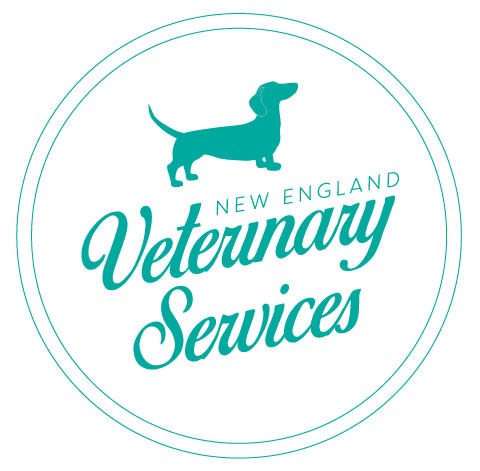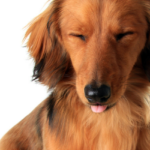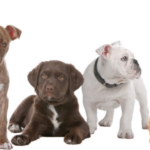Dental disease is one of the most common complaints we see in veterinary practice. In fact, about 3 out of 4 dogs and cats over the age of 2 years of age have some degree of dental disease.
So what is it dental disease in my pet?
Dental disease, or more correctly, periodontal disease (meaning ‘around the tooth’) is any buildup of plaque or calculus (tartar) on the teeth that cause any inflammation in the gums or any change in the structure of the tooth or its attachments. We can grade dental disease on a scale of 1 to 4 with 1 being very mild plaque with little to no gingivitis, and 4 being advanced disease with loss of gum and bone support, and obvious infection of the tissues. Below are some pictures of the 4 grades of disease, and their xray counterparts to show you just how much goes on where we can’t see and why we might ask your permission for dental xrays as they can reveal so much more than is obvious at first glance.
(Images Courtesy of American Veterinary Dental College www.avdc.org)
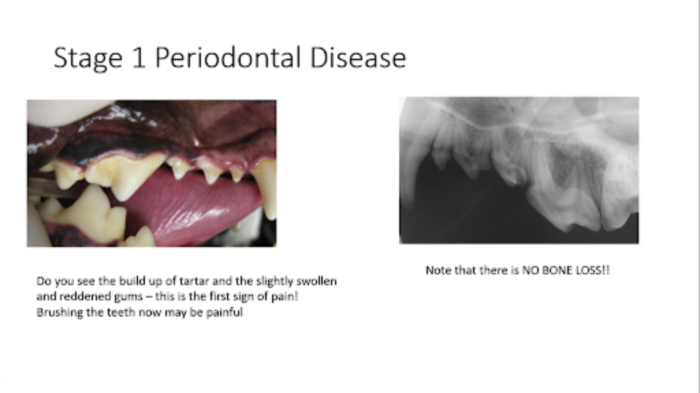
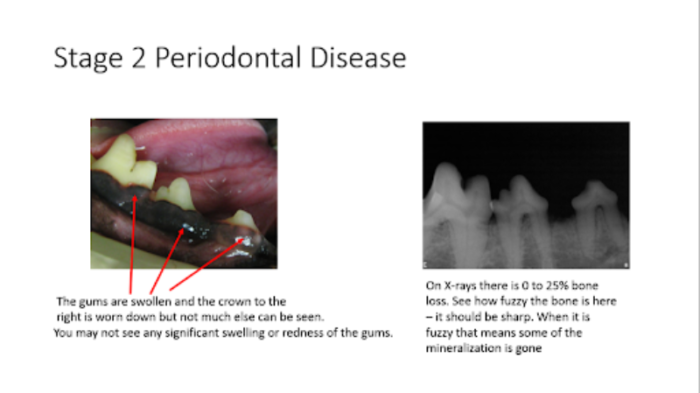
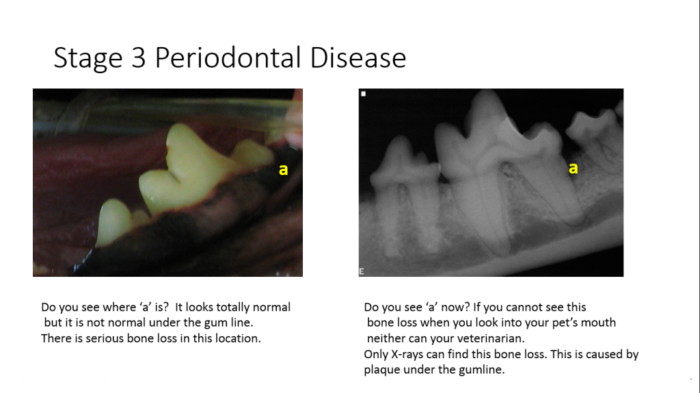
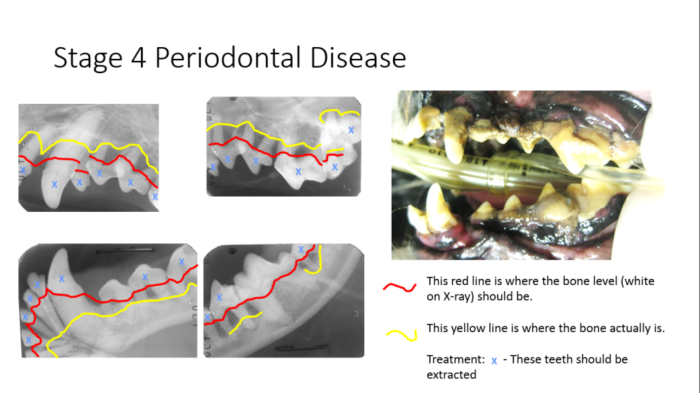
In this last picture above, the loss of bone also weakens the jaw making it more likely to fracture as the bone is thinner, weaker and sometimes infected.
In dogs and cats cavities are relatively uncommon as they don’t have the ‘square’ or flat-topped teeth that we humans have. However the molars do have some crown contacts and if we do see cavities, which are just like those we see in people, this is where we will most likely find them. The contacts on these teeth are pretty hard to see unless you’re right up there in the mouth so often we only come across these when performing a dental clean.
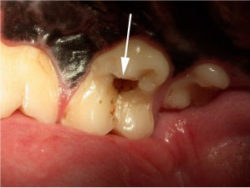
Photo Courtesy of Montana Pet Dental (montanapetdental.com)
Both dogs and cats readily acquire dental disease, but cats have a special lesion that’s all theirs, which is the Feline Oral Resorptive Lesion (sometimes also known as the Feline Odontoclastic Resorptive Lesion, or FORL). These lesions have an unknown cause and affect the majority of cats over their lifetimes, with risk increasing after 2 years of age. They are basically an ulcer, or erosion in the tooth that progresses to consume all of the tooth. Early lesions can be difficult to see, but once the body has tried to cover the deficit with granulation tissue, you may see a pink part to the tooth like this:
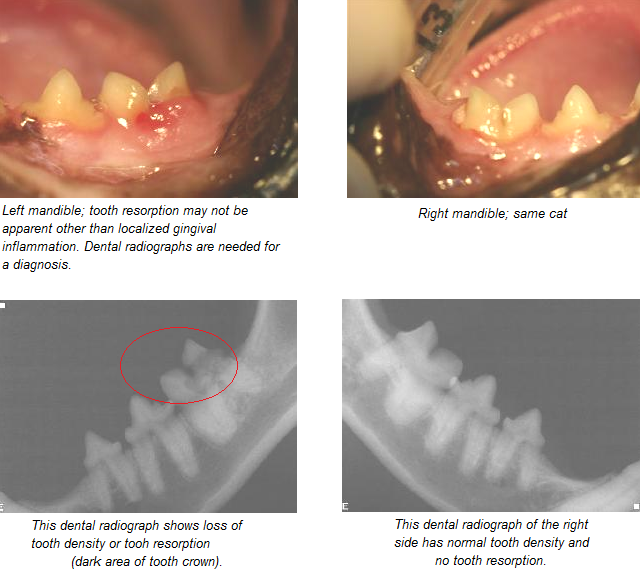
Image Courtesy of Healthy Paws Animal Hospital (https://www.healthypawsanimalhospital.com/resorptive-lesions-feline)
Now this looks really small, not much to worry about but these lesions progress over time, and they are really, really painful. But the accompanying xray shows just how much that tooth is affected by that little lesion. If your cat has these they will try to avoid chewing on that side of the mouth which results in a buildup of plaque on that side, and these guys will ‘chatter’ under general anaesthesia if you probe the lesions. The only treatment is removal of the tooth, although they will eventually fracture off when they advance too far. Not very nice for your kitty though to endure that. Below is a chart indicating all the stages of resorptive lesions. They are most common on the second premolar, but can occur on any, or multiple teeth. When we perform a dental check on your cat this is one of the things we will be looking for.
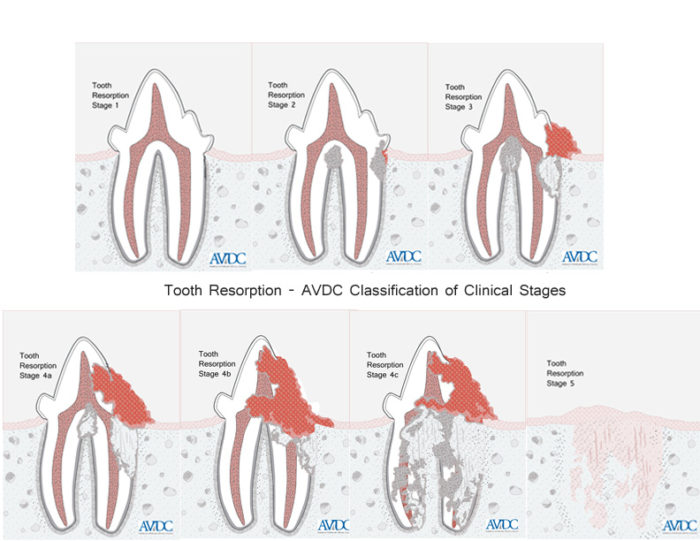
Another less common dental disease Chronic Ulcerative Paradontal Stomatitis (or CUPS). This disease is an autoimmune disease that results from an inappropriate inflammatory response by the body to the plaque present in the mouth. This disease is very painful, results in terrible breath and some animals stop eating altogether because of the pain. Sometimes there are ulcers on the cheeks from the plaque and these are called ‘kissing lesions’. Treatment for this condition is controlling plaque with vigorous and active cleaning, immunosuppressive medications, or alternatively a full-mouth extraction is sometimes needed to provide relief and is effective in most cases. Don’t worry, many animals eat just fine with no teeth, and they are much happier and have a greater appetite post-surgery as their pain resolves. There may be a genetic predisposition to this in some breeds.
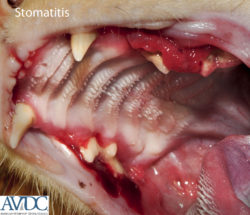
Image courtesy of www.avdc.org. How painful is this mouth! Ouch!!
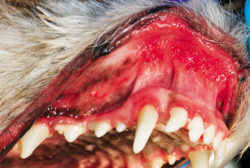
Image courtesy of www.dvm360.com showing ‘kissing lesions’ where the lips touch the teeth.
Other dental issues include malalignments such as those often seen in the short-faced breeds where their lower jaw protrudes, and also a lot of their teeth are crammed in sideways in their short jaws. This results in poor ‘meeting’ of the teeth when the jaw is shut and if the teeth don’t work well together you can gather plaque and end up with periodontal disease. Similarly, retained deciduous (or baby) teeth which we often see in the smaller and toy breeds can result in food becoming trapped and this creates dental disease. We often note these at desexing or at 6 month health checks.
Another really, really common reason for us to perform dental work is tooth fractures. This is relatively common in dogs from chewing hard things or fence-grabbing, or trauma such as car accidents. The fracture disrupts the enamel on the outside of the tooth, and if it exposes the pulp it can create a route of infection to the root tip in the bone of the jaw.
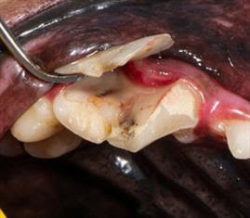
This is a nice example of a slab fracture with exposed pulp cavity. Photo courtesy of vin.com. This will create an abscess in the bone of the face sooner or later.
So after all this what can you do to help your pet keep his or her pearly whites pearly white? The gold standard is daily brushing with a toothbrush (there are special ones designed for pet mouths) or a bit of microfibre cloth. Pet toothpastes are available to help your pet enjoy the experience, but it still takes some degree of training and commitment for your pet to tolerate the procedure. If brushing is not possible, daily or every second day cleaning with commercial chews such as Oravet, Greenies or Dentastix can also be helpful. Meaty bones can be used, but do carry a risk of tooth fracture or getting stuck in the mouth so the recommendation is that the bone should be too big to swallow and be thick. Knuckles or large pieces of thigh bone (cut transversely, not length-wise) have been shown to be efficient at removing plaque. Diets such as Hills t/d or Royal Canin Dental can be very effective, especially in cats and are pretty low-maintenance as the work is done for you as they eat. However t/d is registered with the Veterinary Oral Health Council, whereas the Royal Canin Dental is not, so you will find we have a preference for the Hills t/d.
And finally, regular checks of your pets’ teeth to ensure we are catching problems before they become a big problem. We offer year-round dental checks to help you keep on top of things so book in for a free Dental Check if you aren’t sure what’s going on in your pets’ mouth, or if you’ve noticed bad breath.
What if your pet needs a dental? What is involved?
A dental does involve a general anaesthetic as unfortunately pets won’t allow us to do what we need to do. This is performed with all the care that any anaesthetic is performed with even though dentals are routine procedures. All of our dentals have intravenous fluid support, and we strongly encourage pre-anaesthetic bloodwork. First we will scale the teeth clean, just like they do in humans. Then we probe the gum pockets to ensure they are all normal and the gums are well attached to the teeth. Hopefully we won’t find any surprise pockets where infection has seated below the gumline. If this is the case, we may take some xrays to see what is happening below the gums where we can’t see and we might find that there is an abscess of a tooth root or bone missing, but xrays allow us to non-invasively view what is happening out of sight beneath the tissues. If we need to perform an extraction, we utilise local anaesthetic blocks for your pets’ comfort, as well as creating gum flaps before removing the tooth via sectioning (this is very atraumatic). We then make sure the edges of the tooth socket are smooth for the gum to come back over, and we suture the flap closed so your pet has no open sockets post-operatively, and will heal much faster. They will also, of course, receive extended pain relief and post-dental rechecks to ensure all is going well after the procedure.
Once all teeth are cleaned and any extractions are performed, we then polish all teeth to buff out any scratches in the enamel which may provide a foot-hold for plaque-forming bacteria.
If you have any questions about your pets’ teeth, or what is involved in a dental procedure please call us on 02 6771 0200 to book in for a free dental check at the clinic.
What if my horse needs dental care?
Horses also need regular dental care. Because their teeth grow continuously and are worn down with the grinding of food against each tooth’s opposing tooth any irregularity can quickly compound into a big problem! We recommend horses have their teeth checked at least yearly, especially if they are dropping, or ‘quitting’ their food.
Uneven wear from retained deciduous teeth, missing teeth, infected teeth resulting in an abnormal chewing pattern or cracked teeth can cause ‘wave mouth’ where the teeth align in a ‘wave’ form. This results in poor chewing of food which can cause colics and quitting of food.
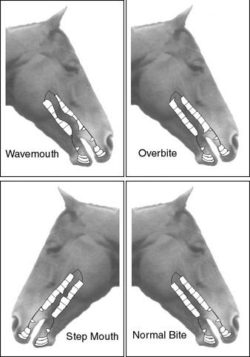
Photo Courtesy of Rick Gore horsemanship
Because horses chew in a sideways motion, hooks on the sides of the teeth which happen over time as the lower arcade lies slightly inside the upper arcade can impede this sideways movement resulting in restricted and painful chewing because of functional immobility because of the hooks, as well as ulcers on the insides of the cheeks as they rub against these points, which again has lead-on effects with nutrition and gut health. If the upper first molar sits just in front of the lower molar, rostral hooks can form that can actually grow into the lower gums!
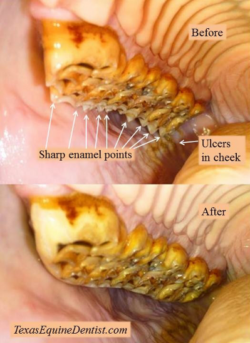
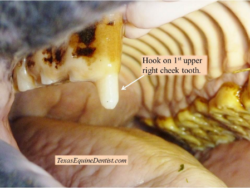
Photos Courtesy of Texas Equine Dental (www.texasequinedentist.com).
Incisors can also have problems from uneven wear resulting in a sloped bite, or if there is a malocclusion such as parrot mouth this can lead to uneven wear and damage to the incisors which are needed for plucking grass from the ground.
Below is an example of severe shear mouth. As you can appreciate this horse would have great difficulty achieving a strong sideways chew with the flat edges of the teeth.
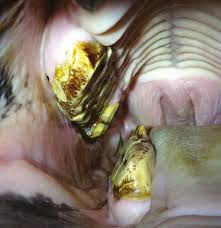
For more information on horse dental care visit: http://www.equinedentistry.co.nz/problems.htm
We are happy to provide dental checks to your horses, however if your horse needs extensive dental care, we recommend using Jo Hoad at our friend clinic Uralla Veterinary Clinic. Jo has completed training in Equine Veterinary Dental Care and has a mobile crush to keep you as well as your horse safe, as well as the knowledge and ability to perform adequate sedations and pain management in your horse. You can call Uralla Veterinary Clinic on 02 6778 3133.

